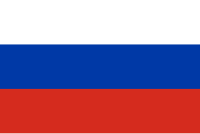White movement
The White movement,[c] also known as the Whites,[d] was one of the main factions of the Russian Civil War of 1917–1922. It was led mainly by the right-leaning and conservative officers of the Russian Empire, while the Bolsheviks who led the October Revolution in Russia, also known as the Reds, and their supporters, were regarded as the main enemies of the Whites. It operated as a loose system of governments and administrations and military formations collectively referred to as the White Army,[e] or the White Guard.[f]
Although the membership of the White movement included people who had a variety of political opinions which were opposed to the rule of the Bolsheviks in Russia, from the republican-minded liberals through monarchists to the ultra-nationalist Black Hundreds,[12][14] and did not have a universally-accepted leader or doctrine,[22] the main force behind the movement were the conservative officers, and the resulting movement shared many traits with widespread right-wing counter-revolutionary movements of the time, namely nationalism, racism, distrust of liberal and democratic politics, clericalism, contempt for the common man and dislike of industrial civilization;[23] in November 1918, the movement united on an authoritarian-right platform around the figure of Alexander Kolchak as its principal leader.[24][25] It generally defended the order of pre-revolutionary Imperial Russia,[14][26][27] although the ideal of the movement was a mythical "Holy Russia", what was a mark of its religious understanding of the world;[28] its positive program was largely summarized in the slogan of "united and indivisible Russia" which meant the restoration of imperial state borders,[17][15][16] and its denial of the right to self-determination.[29] The movement is associated with pogroms and antisemitism, although its relations with the Jews were more complex;[30] it was typical among the White generals to believe that the Revolution was a result of a Jewish conspiracy.[31]
Some historians distinguish the White movement from the so-called "democratic counter-revolution" which was mainly led by the Right SRs and the Mensheviks who adhered to the values of parliamentary democracy and maintained democratic anti-Bolshevik governments (Komuch, Ufa Directory) until November 1918,[32][25] and then supported either the Whites or the Bolsheviks or opposed both factions.
Following the military defeat of their movement, the Whites who were expelled from the USSR attempted to continue the struggle by creating armed groups which would wage guerilla warfare in the USSR. Some of the former White commanders also hoped to depose the Soviet authorities by means of collaboration with Nazi Germany during World War II. In exile, remnants and continuations of the movement remained in several organizations, some of which only had narrow support, enduring within the wider White émigré overseas community until after the fall of the European communist states in the Eastern European Revolutions of 1989 and the subsequent dissolution of the Soviet Union in 1990–1991. This community-in-exile of anti-communists often divided into liberal and the more conservative segments, with some still hoping for the restoration of the Romanov dynasty.
Origins of the name
[edit]In the Russian context after 1917, "White" had three main connotations which were:
- Reference to the French Revolution, where the forces opposing the Revolution and supporting the restoration of Bourbon monarchy used white as their symbolic colour.[33]
- Historical reference to absolute monarchy, specifically recalling Russia's first Tsar, Ivan III (reigned 1462–1505),[34] at a period when some styled the ruler of Muscovy Albus Rex ("the White King").[35]
- The white uniforms of Imperial Russia worn by some White Army soldiers.
Ideology
[edit]| This article is part of a series on |
| Conservatism in Russia |
|---|
 |
Above all, the White movement emerged as opponents of the Red Army.[36] The White Army had the stated aim to reverse the October Revolution and remove the Bolsheviks from power before a constituent assembly (dissolved by the Bolsheviks in January 1918) could be convened.[37] They worked to remove Soviet organizations and functionaries in White-controlled territory.[38]
Overall, the White Army was nationalistic[5] and rejected ethnic particularism and separatism.[39] The White Army generally believed in a united multinational Russia and opposed separatists who wanted to create nation-states.[40]
The propaganda service of the Volunteer Army, the Osvag (Russian: ОСВАГ (ОСВедомительное АГентство), romanized: OSVAG (OSVedomitelnoe AGentstvo), lit. 'Informing Agency'), made the claim that "the Jews must pay for everything: for the February and October revolutions, for Bolshevism and for the peasants who took their land from the owners". The organization also reissued The Protocols of the Elders of Zion. Although Denikin's troops committed only 17.2% of the pogroms (most of which were carried out by Ukrainian nationalists or by rebel armies not affiliated with any side), "white" officers praise soldiers who commit anti-Semitic crimes, some of whom even receive bonuses.[41]
British parliamentary influential leader Winston Churchill (1874–1965) personally warned General Anton Denikin (1872–1947), formerly of the Imperial Army and later a major White military leader, whose forces effected pogroms and persecutions against the Jews:
[M]y task in winning support in Parliament for the Russian Nationalist cause will be infinitely harder if well-authenticated complaints continue to be received from Jews in the zone of the Volunteer Armies.[42]
However, Denikin did not dare to confront his officers and remained content with vague formal condemnations.
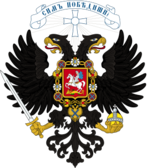
Aside from being anti-Bolshevik and anti-communist[43] and patriotic, the Whites had no set ideology or main leader.[44] The White Armies did acknowledge a single provisional head of state in a Supreme Governor of Russia in a Provisional All-Russian Government, but this post was prominent only under the leadership in the war campaigns during 1918–1920 of Admiral Alexander Kolchak, formerly of the previous Russian Imperial Navy.[45]
The movement had no set foreign policy. Whites differed on policies toward the German Empire in its extended occupation of western Russia, the Baltic states, Poland, and Ukraine on the Eastern Front in the closing days of the World War, debating whether or not to ally with it. The Whites wanted to keep from alienating any potential supporters and allies and thus saw an exclusively monarchist position as a detriment to their cause and recruitment. White-movement leaders, such as Anton Denikin, advocated for Russians to create their own government, claiming the military could not decide in Russians' steads.[46] Admiral Alexander Kolchak succeeded in creating a temporary wartime government in Omsk, acknowledged by most other White leaders, but it ultimately disintegrated after Bolshevik military advances.[6]
Some warlords who were aligned with the White movement, such as Grigory Semyonov and Roman Ungern von Sternberg, did not acknowledge any authority but their own. Consequently, the White movement had no unifying political convictions, as members could be monarchists, republicans,[22] rightists, or Kadets.[47] Among White Army leaders, neither General Lavr Kornilov nor General Anton Denikin were monarchists, yet General Pyotr Nikolayevich Wrangel was a monarchist willing to fight for a republican Russian government. Moreover, other political parties supported the anti-Bolshevik White Army, among them the Socialist Revolutionary Party, and others who opposed Lenin's Bolshevik coup in October 1917. Depending on the time and place, those White Army supporters might also exchange right-wing allegiance for allegiance to the Red Army.
Unlike the Bolsheviks, the White Armies did not share a single ideology, methodology, or political goal. They were led by conservative generals with different agendas and methods, and for the most part they operated quite independently of each other, with little coordination or cohesion. The composition and command structure of White armies also varied, some containing hardened veterans of World War I, others more recent volunteers. These differences and divisions, along with their inability to offer an alternative government and win popular support, prevented the White armies from winning the Civil War.[48][49]
Structure
[edit]White Army
[edit]
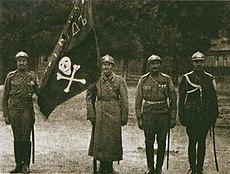
The Volunteer Army in South Russia became the most prominent and the largest of the various and disparate White forces.[36] Starting off as a small and well-organized military in January 1918, the Volunteer Army soon grew. The Kuban Cossacks joined the White Army and conscription of both peasants and Cossacks began. In late February 1918, 4,000 soldiers under the command of General Aleksei Kaledin were forced to retreat from Rostov-on-Don due to the advance of the Red Army. In what became known as the Ice March, they traveled to Kuban in order to unite with the Kuban Cossacks, most of whom did not support the Volunteer Army. In March, 3,000 men under the command of General Viktor Pokrovsky joined the Volunteer Army, increasing its membership to 6,000, and by June to 9,000. In 1919 the Don Cossacks joined the Army. In that year between May and October, the Volunteer Army grew from 64,000 to 150,000 soldiers and was better supplied than its Red counterpart.[50] The White Army's rank-and-file comprised active anti-Bolsheviks, such as Cossacks, nobles, and peasants, as conscripts and as volunteers.
The White movement had access to various naval forces, both seagoing and riverine, especially the Black Sea Fleet.
Aerial forces available to the Whites included the Slavo-British Aviation Corps (S.B.A.C.).[51] The Russian ace Alexander Kazakov operated within this unit.
Administration
[edit]The White movement's leaders and first members[52] came mainly from the ranks of military officers. Many came from outside the nobility, such as generals Mikhail Alekseyev and Anton Denikin, who originated in serf families, or General Lavr Kornilov, a Cossack.
The White generals never mastered administration;[53] they often utilized "prerevolutionary functionaries" or "military officers with monarchististic inclinations" for administering White-controlled regions.[54]
The White Armies were often lawless and disordered.[37] Also, White-controlled territories had multiple different and varying currencies with unstable exchange-rates. The chief currency, the Volunteer Army's ruble, had no gold backing.[55]
Ranks and insignia
[edit]Theatres of operation
[edit]
The Whites and the Reds fought the Russian Civil War from November 1917 until 1921, and isolated battles continued in the Far East until June 1923. The White Army—aided by the Allied forces (Triple Entente) from countries such as Japan, the United Kingdom, France, Greece, Italy and the United States and (sometimes) the Central Powers forces such as Germany and Austria-Hungary—fought in Siberia, Ukraine, and in Crimea. They were defeated by the Red Army due to military and ideological disunity, as well as the determination and increasing unity of the Red Army.
The White Army operated in three main theatres:
Southern front
[edit]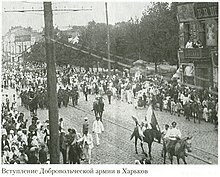
White organising in the South started on 15 November 1917, (Old Style) under General Mikhail Alekseyev. In December 1917, General Lavr Kornilov took over the military command of the newly named Volunteer Army until his death in April 1918, after which General Anton Denikin took over, becoming head of the "Armed Forces of the South of Russia" in January 1919.
The Southern Front featured massive-scale operations and posed the most dangerous threat to the Bolshevik Government. At first it depended entirely upon volunteers in Russia proper, mostly the Cossacks, among the first to oppose the Bolshevik Government. On 23 June 1918, the Volunteer Army (8,000–9,000 men) began its so-called Second Kuban Campaign with support from Pyotr Krasnov. By September, the Volunteer Army comprised 30,000 to 35,000 members, thanks to mobilization of the Kuban Cossacks gathered in the North Caucasus. Thus, the Volunteer Army took the name of the Caucasus Volunteer Army. On 23 January 1919, the Volunteer Army under Denikin oversaw the defeat of the 11th Soviet Army and then captured the North Caucasus region. After capturing the Donbas, Tsaritsyn and Kharkiv in June, Denikin's forces launched an attack towards Moscow on 3 July, (N.S.). Plans envisaged 40,000 fighters under the command of General Vladimir May-Mayevsky storming the city.
After General Denikin's attack upon Moscow failed in 1919, the Armed Forces of the South of Russia retreated. On 26 and 27 March 1920, the remnants of the Volunteer Army evacuated from Novorossiysk to the Crimea, where they merged with the army of Pyotr Wrangel.
Eastern (Siberian) front
[edit]The Eastern Front started in spring 1918 as a secret movement among army officers and right-wing socialist forces. In that front, they launched an attack in collaboration with the Czechoslovak Legions, who were then stranded in Siberia by the Bolshevik Government, who had barred them from leaving Russia, and with the Japanese, who also intervened to help the Whites in the east. Admiral Alexander Kolchak headed the eastern White Army and a provisional Russian government. Despite some significant success in 1919, the Whites were defeated being forced back to Far Eastern Russia, where they continued fighting until October 1922. When the Japanese withdrew, the Soviet army of the Far Eastern Republic retook the territory. The Civil War was officially declared over at this point, although Anatoly Pepelyayev still controlled the Ayano-Maysky District at that time. Pepelyayev's Yakut revolt, which concluded on 16 June 1923, represented the last military action in Russia by a White Army. It ended with the defeat of the final anti-communist enclave in the country, signalling the end of all military hostilities relating to the Russian Civil War.
Northern and Northwestern fronts
[edit]Headed by Nikolai Yudenich, Evgeni Miller, and Anatoly Lieven, the White forces in the North demonstrated less co-ordination than General Denikin's Army of Southern Russia. The Northwestern Army allied itself with Estonia, while Lieven's West Russian Volunteer Army sided with the Baltic nobility. Authoritarian support led by Pavel Bermondt-Avalov and Stanisław Bułak-Bałachowicz played a role as well. The most notable operation on this front, Operation White Sword, saw an unsuccessful advance towards the Russian capital of Petrograd in the autumn of 1919.
Post–Civil War
[edit]
The defeated anti-Bolshevik Russians went into exile, congregating in Belgrade, Berlin, Paris, Harbin, Istanbul, and Shanghai. They established military and cultural networks that lasted through World War II (1939–1945), e.g. the Harbin and Shanghai Russians. Afterward, the White Russians' anti-communist activists established a home base in the United States, to which numerous refugees emigrated.
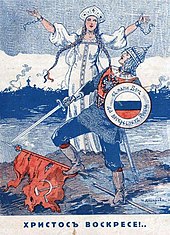
Moreover, in the 1920s and the 1930s the White movement established organisations outside Russia, which were meant to depose the Soviet government with guerrilla warfare, e.g., the Russian All-Military Union, the Brotherhood of Russian Truth, and the National Alliance of Russian Solidarists, a far-right anticommunist organization founded in 1930 by a group of young White emigres in Belgrade, Yugoslavia. Some White émigrés adopted pro-Soviet sympathies and were termed "Soviet patriots". These people formed organizations such as the Mladorossi, the Eurasianists, and the Smenovekhovtsy. A Russian cadet corps was established to prepare the next generation of anti-Communists for the "spring campaign"—a hopeful term denoting a renewed military campaign to reclaim Russia from the Soviet Government. In any event, many cadets volunteered to fight for the Russian Protective Corps during World War II, when a number of White Russians collaborated with Nazi Germany.[56] The collaborators included some prominent figures of the White movement, like Pyotr Krasnov, the leader of the White Don Cossacks during the civil war.

After the war, active anti-Soviet combat was almost exclusively continued by the National Alliance of Russian Solidarists. Other organizations either dissolved, or began concentrating exclusively on self-preservation and/or educating the youth. Various youth organizations, such as the Russian Scouts-in-Exteris, promoted providing children with a background in pre-Soviet Russian culture and heritage. Some supported Zog I of Albania during the 1920s and a few independently served with the Nationalists during the Spanish Civil War. White Russians also served alongside the Soviet Red Army during the Soviet invasion of Xinjiang and the Islamic rebellion in Xinjiang in 1937.
Prominent people
[edit]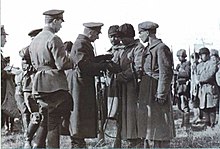
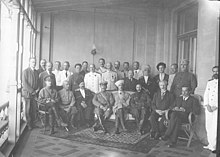

- Mikhail Alekseyev
- Vladimir Antonov
- Nicholas Savich Bakulin
- Pavel Bermondt-Avalov
- Stanisław Bułak-Bałachowicz
- Anton Denikin
- Mikhail Diterikhs
- Mikhail Drozdovsky
- Alexander Dutov
- Dmitrii Fedotoff-White
- Ivan Ilyin
- Nikolay Iudovich Ivanov
- Alexey Kaledin
- Vladimir Kantakuzen
- Vladimir Kappel
- Alexander Kolchak
- Lavr Kornilov
- Pyotr Krasnov
- Mikhail Kvetsinsky
- Alexander Kutepov
- Anatoly Lieven
- Konstantin Mamontov
- Sergey Markov
- Vladimir May-Mayevsky
- Evgeny Miller
- Najmuddin of Gotzo
- Konstantin Petrovich Nechaev
- Viktor Pokrovsky
- Leonid Punin
- Aleksandr Rodzyanko
- Grigory Semyonov
- Andrei Shkuro
- Roman von Ungern-Sternberg
- Pyotr Nikolayevich Wrangel
- Sergei Wojciechowski
- Nikolai Yudenich
- Boris Annenkov
Related movements
[edit]After the February Revolution, in western Russia, Finland, Estonia, Latvia, and Lithuania declared themselves independent, but they had a substantial Communist or Russian military presence. Civil wars followed, wherein the anti-communist side may be referred to as White Armies, e.g. in Finland the White Guard-led, partially conscripted Finnish White Army (Finnish: Valkoinen Armeija) who fought against Soviet Russia-sponsored Red Guards. However, since they were nationalists, their aims were substantially different from the Russian White Army proper; for instance, Russian White generals never explicitly supported Finnish independence. The defeat of the Russian White Army made the point moot in this dispute. The countries remained independent and governed by non-Communist governments.
See also
[edit]- Russian State (1918–1920)
- 1st Infantry Brigade (South Africa)
- Allied intervention in the Russian Civil War
- Basmachi movement
- Czechoslovak Legions
- Estonian War of Independence
- Finnish Civil War
- Grand Orient of Russia's Peoples
- Great Siberian Ice March
- Italian Legione Redenta
- Russian All-Military Union
- Russian diaspora
- Red Terror
- Soviet–Ukrainian War
- White Terror (Russia)
- Ukrainian War of Independence
Notes
[edit]- ^
- Provisional All-Russian Government: Russian: Вре́менное Всеросси́йское прави́тельство, romanized: Vrémennoye Vserossíyskoye pravítel'stvo
- Directory: Russian: Директо́рия, romanized: Direktóriya
- Ufa Directory: Russian: Уфи́мская Директо́рия, romanized: Ufímskaya Direktóriya
- Omsk Directory: Russian: О́мская Директо́рия, romanized: Ómskaya Direktóriya
- ^ Mensheviks and SRs made attempts to overthrow the White administrations and create their own such as the "Political Centre" in 1920[21]
- ^ Russian: pre–1918 Бѣлое движеніе / post–1918 Белое движение, romanized: Beloye dvizheniye, IPA: [ˈbʲɛləɪ dvʲɪˈʐenʲɪɪ]. The old spelling was retained by the Whites to differentiate from the Reds.
- ^ Russian: Бѣлые / Белые, romanized: Beliye.
- ^ Russian: Бѣлая армія / Белая армия, romanized: Belaya armiya.
- ^ Russian: Бѣлая гвардія / Белая гвардия, romanized: Belaya gvardiya.
References
[edit]Footnotes
[edit]- ^ Evan Mawdsley (2008) The Russian Civil War: 27
- ^ "ETIS - Rets.: Reigo Rosenthal, Loodearmee, Tallinn: Argo, 2006". www.etis.ee. Retrieved 2019-01-10.
- ^ The White Guard Archived 25 February 2020 at the Wayback Machine // "Banquet Campaign" of 1904 – Big Irgiz – Moscow: The Great Russian Encyclopedia, 2005 – Page 190 – (The Great Russian Encyclopedia: in 35 Volumes / Editor-in-Chief Yury Osipov; 2004–2017, Volume 3) – ISBN 5-85270-331-1
- ^ "The White armies". Alpha History. 15 August 2019. Archived from the original on 5 April 2023. Retrieved 30 March 2021.
- ^ a b c Kenez 1980, p. 74.
- ^ a b Предисловие // Красный террор в годы Гражданской войны: По материалам Особой следственной комиссии по расследованию злодеяний большевиков. Archived 2020-08-08 at the Wayback Machine / Под ред. докторов исторических наук Ю. Г. Фельштинского и Г. И. Чернявского — London, 1992. "Yuri Felshtinsky writes that there were differences in the ideology of the White movement, but the prevailing desire was to restore a democratic, parliamentary political system, private property and market relations in Russia."
- ^ Никулин В.В., Красников В.В., Юдин А.Н. (2005). Советская Россия: Проблемы социально-экономического и политического развития (PDF). Тамбов: Издательство ТГТУ. ISBN 5-8265-0394-7.
{{cite book}}: CS1 maint: multiple names: authors list (link) "Архивированная копия" (PDF). Archived from the original on 2012-01-03. Retrieved 2020-04-25. - ^ The White Movement and the National Question in Russia: a collective monograph. / Edited by Doctor of Historical Sciences, Professor V. T. Tormozov, Candidate of Historical Sciences A. G. Pismensky. Authors: V. T. Tormozov, A. A. Ivanova, and others. — Moscow: Saratov State University Publishing House, 2009. — 157 p. —ISBN 978-5-8323-0602-5.
- ^ Kenez, 1980.
- ^ Peter Kenez (2008). Red Advance, White Defeat: Civil War in South Russia 1919–1920. New Acdemia+ORM. ISBN 9781955835176.
- ^ Oberländer, Erwin (1966). "The All-Russian Fascist Party". Journal of Contemporary History. 1 (1): 158–173. doi:10.1177/002200946600100110. ISSN 0022-0094. JSTOR 259654. Retrieved 23 November 2024.
- ^ a b Osborne, R. (2023, April 14). White Army of Russia | History, Significance & Composition. Study.com. "Loosely commanded by former imperial admiral Alexander Kolchack, the White Army was comprised of volunteers, conscripts, liberals, conservatives, monarchists, religious fundamentalists, and any group that opposed Bolshevik rule. These various groups had little in common besides their opposition to Bolshevik rule."
- ^ Slashchov-Krymsky Ya. A. White Crimea, 1920: Memoirs and documents. Moscow, 1990. P. 40. "According to the leader of the defense of Crimea from the Bolsheviks in the winter of 1920, General Ya. A. Slashchev-Krymsky , the White movement was a mixture of the pro-Cadet and pro-Octobrist upper classes and the Menshevik - SR lower classes."
- ^ a b c "Первая лекция историка К. М. Александрова о Гражданской войне. Часть первая". belrussia.ru. St. Petersburg. 5 January 2010. Archived from the original on 2010-10-31. Retrieved 2010-10-18.
The White movement as a whole, despite the presence of political shades: republicans, monarchists, non-predeterminists, was a military-political movement that defended the values of Stolypin's Russia.
- ^ a b The People in Arms: Military Myth and National Mobilization Since the French Revolution. Cambridge University Press. 2 November 2006. ISBN 978-0-521-03025-0.
- ^ a b Robinson, Paul (2002). "Civil War". The White Russian Army in Exile 1920-1941. Oxford University Press. pp. 1–15. doi:10.1093/acprof:oso/9780199250219.003.0001. ISBN 978-0-19-925021-9.
- ^ a b "In the Wake of Empire".
- ^ Rinke, Stefan; Wildt, Michael (2017). Revolutions and Counter-Revolutions: 1917 and Its Aftermath from a Global Perspective. Campus Verlag. p. 58. ISBN 978-3593507057.
- ^ "YIVO | Russian Civil War". yivoencyclopedia.org. Retrieved 2022-11-08.
- ^ Joana Breidenbach (2005). Pál Nyíri, Joana Breidenbach (ed.). China inside out: contemporary Chinese nationalism and transnationalism (illustrated ed.). Central European University Press. p. 90. ISBN 978-963-7326-14-1. Retrieved 18 March 2012.
Then there occurred another story which has become traumatic, this one for the Russian nationalist psyche. At the end of the year 1918, after the Russian Revolution, the Chinese merchants in the Russian Far East demanded the Chinese government to send troops for their protection, and Chinese troops were sent to Vladivostok to protect the Chinese community: about 1600 soldiers and 700 support personnel.
- ^ The Soviet High Command: A Military-political History, 1918-1941: A Military Political History, 1918-1941. Routledge. 4 July 2013. ISBN 978-1-136-33959-2.
- ^ a b Kenez 1980, p. 59.
- ^ Kenez 1980, p. 80.
- ^ А. В. Шубин. "Великая Российская революция. 10 вопросов" (PDF) (in Russian).
Authoritarian tendencies also prevailed in the territory occupied by the opponents of the Soviet Republic. The militarization of life, the growth of the influence of officers, and the strengthening of right-wing socio-political groups led to the evolution of the political system to the right. [...] On the night of November 18, 1918, the army overthrew the Directory, handing over power to the Supreme Ruler, Admiral A. Kolchak. His dictatorship was supported by other leaders of the White movement.
- ^ a b Russia in Revolution: An Empire in Crisis, 1890 to 1928. Oxford University Press. 2017. ISBN 978-0-19-873482-6.
- ^ А. В. Шубин. 1918 год. Революция, кровью омытая (in Russian). p. 531. ISBN 978-5-8291-2317-8.
...with the ritual condemnation of reaction, the goal of the movement was to restore order, in its main features corresponding to the pre-revolutionary one.
- ^ Peter Kenez (2008). Red Advance, White Defeat: Civil War in South Russia 1919–1920. New Acdemia+ORM. ISBN 9781955835176.
Not all the participants in the White movement wanted to recreate tsarist Russia. [...] Nevertheless, the Civil War divided those who preferred tsarist Russia to the society which they feared their country was heading toward, and those who hated the old and had confidence that they could build a more just and rational society. After three years of struggle the Whites lost the war, proving that the traditional order had too few defenders... The defeat of the Whites was the final and conclusive defeat of Imperial Russia.
- ^ The Bolsheviks in Russian Society: The Revolution and the Civil Wars. Yale University Press. January 1997. ISBN 978-0-300-14634-9.
- ^ А. В. Шубин. "Великая Российская революция. 10 вопросов" (PDF) (in Russian).
The White movement fought for the "united and indivisible" Russia and did not recognize the right of nations to self-determination.
- ^ Oleg Budnitskii (2012). Russian Jews Between the Reds and the Whites, 1917-1920. University of Pennsylvania Press. p. 3. ISBN 9780812208146.
- ^ Suny, Ronald (14 November 2017). Red Flag Unfurled: History, Historians, and the Russian Revolution. Verso Books. pp. 1–320. ISBN 978-1-78478-566-6.
- ^ https://www.cambridge.org/core/journals/nationalities-papers/article/abs/democratic-counterrevolution-of-1918-in-siberia/902F77B1E6F60CF8CC8EDFCB66A3894
- ^ A/AS Level History for AQA Revolution and Dictatorship: Russia, 1917–1953 Student Book. Cambridge University Press. 4 February 2016. ISBN 978-1-107-58738-0.
- ^ Lehtovirta, Jaako (2002). "The Use of Titles in Heberstein's 'Commentarii'. Was the Muscovite Tsar a King or an Emperor?". In von Gardner, Johann (ed.). Schriften zur Geistesgeschichte des östlichen Europa [Essays on the intellectual history of eastern Europe]. Wiesbaden: Otto Harrassowitz Verlag. p. 190. ISSN 0340-6490. Retrieved 31 July 2015.
It was Ivan III (1462–1505) who is well known as the first one to present himself as a tsar to foreigners, though it must be accepted that his use of the title was very sparse.
- ^ Lehtovirta, Jaako (2002). "The Use of Titles in Heberstein's 'Commentarii'. Was the Muscovite Tsar a King or an Emperor?". In von Gardner, Johann (ed.). Schriften zur Geistesgeschichte des östlichen Europa [Essays on the intellectual history of eastern Europe]. Wiesbaden: Otto Harrassowitz Verlag. p. 189. ISSN 0340-6490. Retrieved 31 July 2015.
[...] the brief mention that the Muscovite ruler is by some called 'the White King' ('albus rex').
- ^ a b Kenez 1980.
- ^ a b Christopher Lazarski, "White Propaganda Efforts in the South during the Russian Civil War, 1918–19 (The Alekseev-Denikin Period)", The Slavonic and East European Review, Vol. 70, No. 4 (Oct., 1992), pp. 688–707.
- ^ Viktor G. Bortnevski, "White Administration and White Terror (The Denikin Period)", Russian Review, Vol. 52, No. 3 (Jul., 1993), pp. 354–366.
- ^ Christopher Lazarski, "White Propaganda Efforts," 689.
- ^ Kenez 1980, p. 62.
- ^ Rubenstein, Richard L., and John K. Roth. Approaches to Auschwitz: The Legacy of the Holocaust. London: SCM, 1987, p. 138.
- ^ Joseph Cohen, Michael (1985). Churchill and the Jews. Psychology Press. ISBN 978-0-7146-3254-4. Archived from the original on 2016-05-21.
- ^ Christopher Lazarski, "White Propaganda Efforts," 690.
- ^ Kenez 1980, pp. 58–59.
- ^ "Первая лекция историка К. М. Александрова о Гражданской войне. Часть первая". www.belrussia.ru. 18 January 2010. Retrieved 3 February 2024.
- ^ Kenez 1980, p. 69.
- ^ Kenez, Peter, Civil War, 90.
- ^ Двухнедѣльный военный и военно-морской журналъ «Часовой»: органъ связи русскаго воинства за рубежомъ подъ ред. В. В. Орѣхова и Евгенія Тарусскаго, — Paris, 1 мая 1932. — № 79. Archived 2010-12-17 at the Wayback Machine
- ^ Цветков В. Ж. (2005). Белое движение (Большая российская энциклопедия: В 30 т. Т. 3: «Банкетная кампания» 1904 — Большой Иргиз / Председатель Науч.-ред. совета Ю. С. Осипов, отв. ред. С. Л. Кравец ed.). Moscow: Большая Российская энциклопедия.
- ^ Kenez, Peter, Civil War, 18–22.
- ^ "The R.A.F. in Russia". The Aeroplane. 17 (1): 82. 1919. Archived from the original on 27 June 2014. Retrieved 9 February 2014.
Soon after landing we started to recruit for the Slavo-British Aviation Corps (S.B.A.C.) [...].
- ^ Kenez, Peter, Civil War, 18.
- ^ Kenez 1980, p. 65.
- ^ Viktor G. Bortnevski, White Administration and White Terror, 360.
- ^ Kenez, Peter, Civil War, 94–95.
- ^ Beyda, Oleg (2014). "'Iron Cross of the Wrangel's Army': Russian Emigrants as Interpreters in the Wehrmacht". The Journal of Slavic Military Studies. 27 (3): 430–448. doi:10.1080/13518046.2014.932630. ISSN 1351-8046. S2CID 144274571.
Bibliography
[edit]- Kenez, Peter (1980). "The Ideology of the White Movement". Soviet Studies. 32 (32): 58–83. doi:10.1080/09668138008411280.
- Kenez, Peter (1977). Civil War in South Russia, 1919–1920: The Defeat of the Whites. Berkeley: University of California Press.
- Kenez, Peter (1971). Civil War in South Russia, 1918: The First Year of the Volunteer Army. Berkeley: University of California Press.

